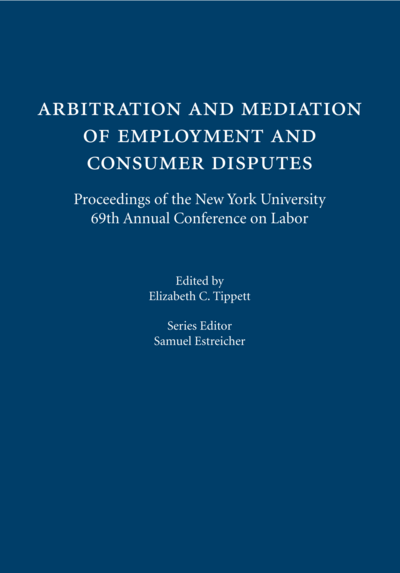Arbitration and Mediation of Employment and Consumer Disputes
Proceedings of the New York University 69th Annual Conference on Labor
Edited by: Elizabeth C. Tippett, Samuel Estreicher
2018
Tags: ADR/Negotiation/Mediation, Labor/Employment Law
320 pp $225.00
ISBN 978-1-5310-0931-1
Arbitration has long been central to resolving disputes in the labor law context. However, in non-unionized settings, arbitration represents an alternate path for disputes otherwise destined for court. It is perhaps surprising, then, that the National Labor Relations Board represents the last holdout against Supreme Court precedent favoring enforcement of arbitration agreements containing class action waivers.
This volume brings together scholars and practitioners from the fields of labor law, employment law, and alternative dispute resolution to share their insights. Acting NLRB Chair, Philip Miscimarra, describes the NLRB's "complicated" relationship with arbitration. Labor lawyers on both sides of the debate (Willis Goldsmith & Blake Pulliam, Jae Chun, and Kalpana Kotagal) offer their perspectives on the upcoming Supreme Court rulings. Labor lawyers Eugene Eisner and Daniel Engelstein then draw upon their considerable experience with labor arbitration to assess the relative benefits and limitations of arbitration in a non-unionized context. Zev Eigen and David Sherwyn then provide a deep dive on how arbitration compares to administrative remedies and litigation in discrimination cases.
Next, scholars advise on legal issues surrounding arbitration. Christopher Drahozal assesses whether arbitration awards have collateral estoppel effect. ADR commentator Lise Gelernter describes the circumstances are class action waivers enforceable. Michael Leroy uses the "deflategate" scandal at the NFL to examine judicial review of arbitration awards. And Brian Farkas examines the the interaction between non-compete provisions and arbitration provisions.
Practitioners and scholars also describe dispute resolution systems in other contexts. Terry Meginniss & Paul Salvatore discuss a dispute resolution system developed by the parties to the Pyett litigation. Jill Rosenberg offers an overview of arbitration in the securities industry. Daniel Hund describes how mediation and arbitration interact with the court system in Europe. David Noll examines the Consumer Financial Protection Bureau's rulemaking regarding arbitration. The volume closes with two articles about dispute resolution in the medical context. Dean Alan Morrison profiles a dispute resolution system used in the medical malpractice context, and David Larson and David Dahl describe the dispute resolution preferences of doctors.


